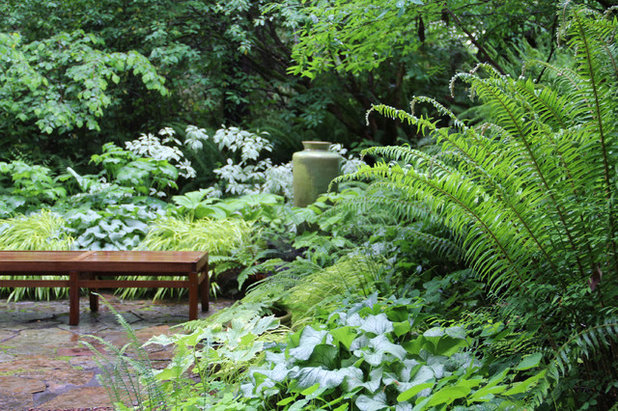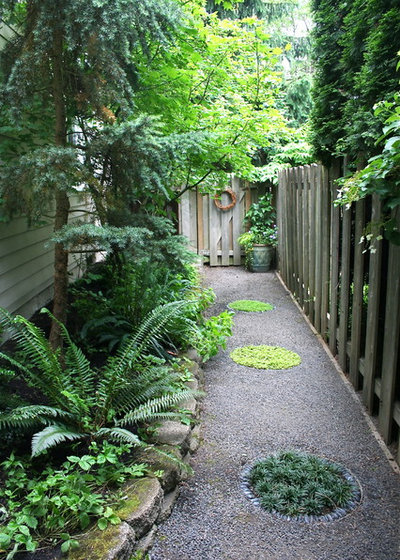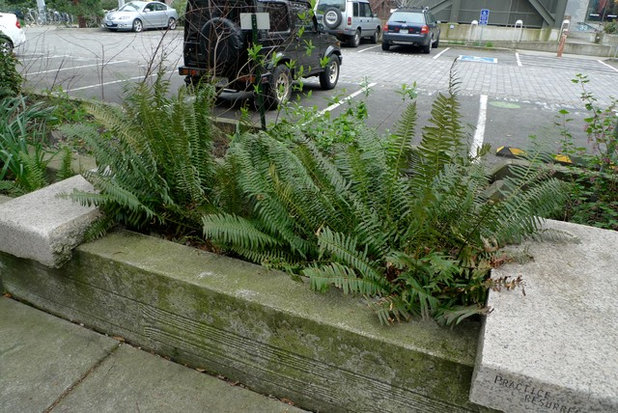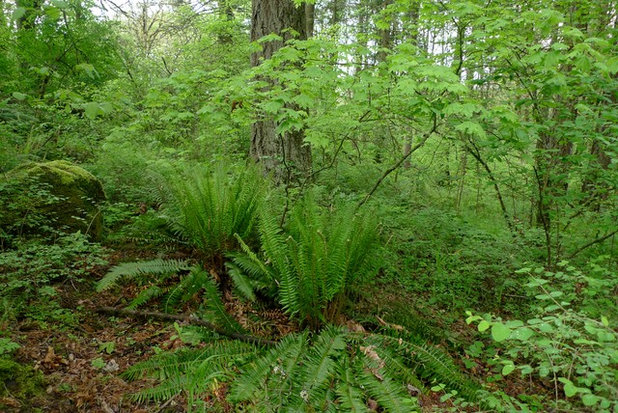While commonly seen in the Pacific Northwest, western sword fern (
Polystichum munitum) is nevertheless one of the region’s most visually distinctive — even dramatic — native plants. Its dark green, prehistoric-looking fronds can reach nearly 5 feet in height and width, and it looks as striking rising from a smooth bed of moss as it does cloaking the vast hillsides of a mixed deciduous-coniferous forest.
Western sword fern is sometimes overlooked as a garden plant because it’s seen as boring or straggly. But simple tending — the same quick spring pruning any garden perennial would receive at the beginning of the season — is enough to turn a sword fern from rumpled to elegant in one fell swoop. To its clean good looks (postpruning), add that it is incredibly adaptable and requires virtually no care once established.

Bliss Garden Design
Botanical name: Polystichum munitumCommon names: Western sword fern, western swordfern
Origin: Western North America from Alaska to California and east to the Rocky Mountains
Where it will grow: Hardy to -40 degrees Fahrenheit (USDA zones 3 to 10; find your zone)
Water requirement: Little to no supplemental water in the Pacific Northwest when planted in shade
Light requirement: Partial to full shade
Mature size: 3 to 5 feet tall
Benefits and tolerances: Shade tolerant; drought tolerant in the Pacific Northwest (may require supplemental water in the southern part of the range); requires virtually no care apart from spring pruning if planted in a manicured area of the garden
Seasonal interest: Attractive year-round, but especially in spring when bright new fronds appear, and through winter when the rich green foliage provides a lively foil to mosses, ground covers or bare earth
W
hen to plant: Fall to spring is ideal
In moist, shady areas, western sword fern can grow up to 5 feet tall and wide, and can make a fine backdrop for smaller ground cover plants.

Visionscapes NW Landscape Design
Distinguishing traits. Western sword fern has strong, vertical lines in spring, when bright green new croziers appear, unfurling to 3 to 5 feet tall, depending on moisture levels in the soil. As the season progresses, the foliage turns a rich green and gradually relaxes.
Western sword ferns provide winter color and structure, when most native plants around them are dormant. In winter dark green fronds enliven the gray and brown tones of sky and earth and create a handsome evergreen silhouette.

Kate Bryant
How to use it. Plant on north- and east-facing hillsides, banks and stone walls, where greenery and soil stability are needed. Sword ferns grow largest and most lushly in moist, shady areas, but they also do well with a full morning of sun or dappled light throughout the day. They can survive in full sun with sufficient water but will have a stunted look.
Western sword fern is versatile in gardens, looking as good in a semi-formal, manicured setting as in wilder areas. Sword ferns are valued in Asian-style gardens, rising from moss or low ground covers. A single sword fern in a simple, deep planter by a door can be surprisingly elegant and understated.

Kate Bryant
Planting notes. Once established, western sword fern can tolerate the typical Pacific Northwest summer drought, although a bit of supplemental summer water in a garden setting can maintain the most lustrous, deep green foliage.
It’s a long-lived plant, and it can grow in a log or crevice as well as in the ground. Well-drained but moist soil results in the lushest growth. New growth pushes up from the center. In a garden setting, trim last year’s flattened foliage for a tidier look.





